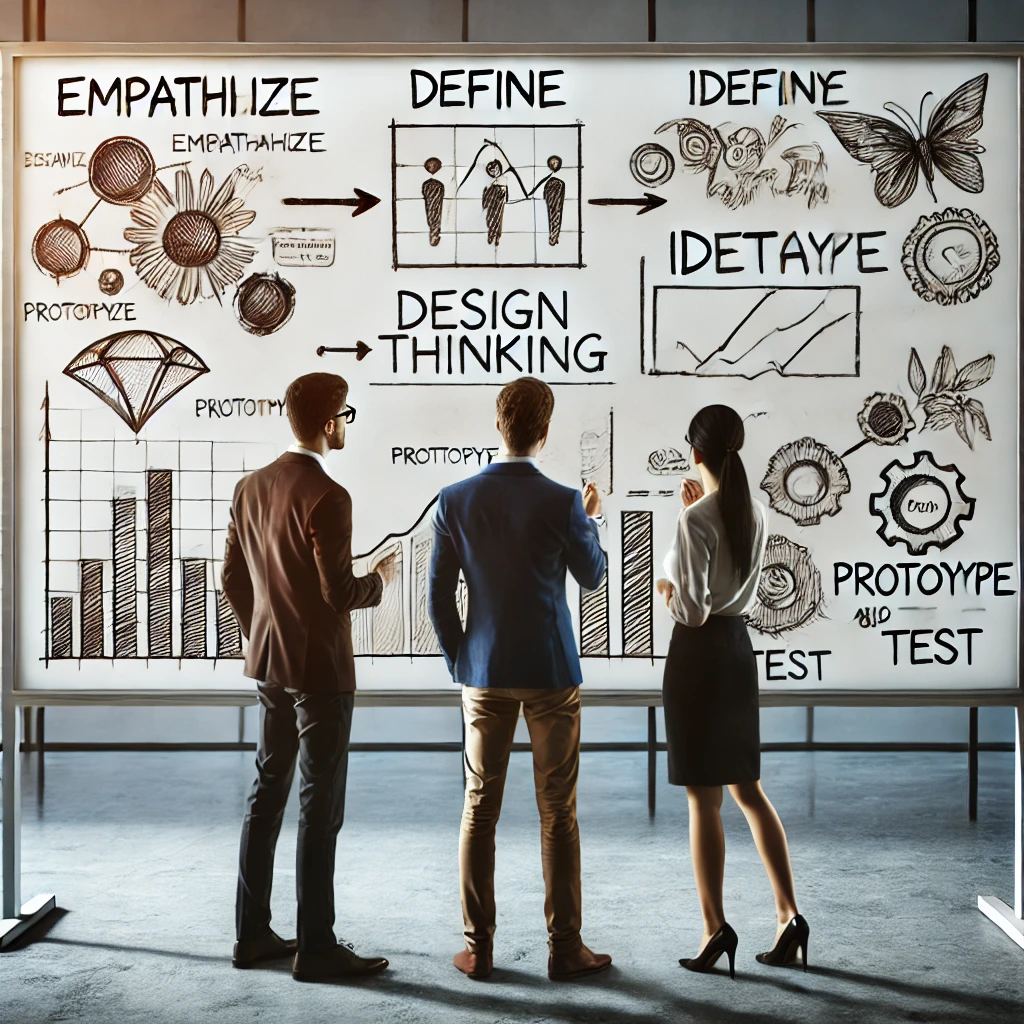Introduction
In the fast-paced world of product and software development, teams constantly seek methodologies that foster innovation, efficiency, and user-centric solutions. One such approach, Design Thinking, has gained widespread recognition as an effective method for solving complex problems and driving creative solutions. While Design Thinking has proven to be a powerful tool for product and service development, it also comes with challenges and limitations that need to be considered.
This article explores the core principles of Design Thinking, its benefits, and the potential pitfalls that can arise when applying this methodology in real-world projects.
What is Design Thinking?
Design Thinking is a problem-solving methodology that prioritizes user needs, iterative development, and cross-disciplinary collaboration. It is rooted in design principles but extends beyond design teams, being widely adopted in engineering, business, and social innovation.
The Five Stages of Design Thinking
The methodology is typically broken down into five stages:
- Empathize – Understand users, their challenges, and their needs through research, observation, and direct engagement.
- Define – Synthesize insights from the research phase to clearly articulate the core problem.
- Ideate – Brainstorm and generate creative solutions, often through collaboration and structured innovation exercises.
- Prototype – Create low-fidelity models of potential solutions to test feasibility and user reactions.
- Test – Gather feedback from users and refine the prototype iteratively to improve the solution.
Design Thinking is non-linear, meaning teams often cycle between these stages based on feedback and evolving project requirements.
Benefits of Design Thinking
The adoption of Design Thinking has brought substantial benefits to organizations and teams that integrate it into their development process.
User-Centric Approach
One of the greatest strengths of Design Thinking is its emphasis on empathy. By deeply understanding the user’s needs, behaviors, and pain points, teams can create products and services that truly address real-world problems.
Encourages Innovation
Through brainstorming and prototyping, Design Thinking fosters creativity and encourages out-of-the-box thinking. This is especially valuable in industries where traditional, linear problem-solving methods may lead to stagnation.
Reduces Risk in Development
By iterating early and often, teams can test ideas and discard ineffective ones before investing significant resources in full-scale development. This approach reduces the risk of costly failures later in the process.
Promotes Cross-Disciplinary Collaboration
Design Thinking encourages input from diverse teams, including designers, engineers, marketers, and end-users. This multidisciplinary approach leads to well-rounded solutions that consider multiple perspectives.
Accelerates Problem-Solving
The iterative nature of Design Thinking allows teams to quickly test and refine ideas. Instead of spending months on theoretical planning, teams can rapidly move from ideation to tangible solutions.
Enhances Customer Satisfaction
Products and services developed through Design Thinking tend to align closely with user expectations, leading to higher customer satisfaction, loyalty, and adoption rates.
Challenges and Limitations of Design Thinking
Despite its many advantages, Design Thinking is not a perfect solution and can introduce several challenges when implemented improperly or in the wrong context.
Time-Consuming Process
Although Design Thinking is meant to accelerate problem-solving, the methodology itself can be time-intensive. The emphasis on research, testing, and iteration means that projects may take longer to reach final implementation compared to more traditional methods.
Difficult to Implement in Traditional Workflows
Many organizations operate within rigid structures that prioritize efficiency, deadlines, and budgets. Design Thinking, with its iterative and exploratory nature, can be difficult to integrate into such environments.
Risk of Over-Reliance on Qualitative Data
The methodology places significant emphasis on user interviews, observations, and qualitative insights. While this is valuable, it can sometimes lead to solutions that are not backed by robust quantitative data, causing challenges in decision-making.
Potential for Idea Overload
Brainstorming and ideation often generate a flood of creative solutions, but not all are viable. Without strong project management, teams can get lost in an overwhelming number of ideas without clear prioritization.
Requires Skilled Facilitators
Applying Design Thinking effectively requires experienced facilitators who can guide teams through the methodology. Without proper leadership, workshops can become unstructured and ineffective.
Not Always Suitable for All Projects
While Design Thinking works well for user-centric innovation, it is not ideal for every type of project. For example, in highly technical fields where engineering constraints are the primary concern, a more structured approach such as Agile, Lean, or Six Sigma may be more appropriate.
Balancing Design Thinking with Other Methodologies
To maximize effectiveness, many organizations integrate Design Thinking with other development methodologies, such as:
- Agile Development: Design Thinking can help define user needs and generate creative solutions, which Agile teams can then iteratively develop and refine.
- Lean Startup: The prototyping and testing phases of Design Thinking align well with Lean Startup’s Build-Measure-Learn cycle.
- Systems Thinking: For complex problems involving multiple stakeholders and interdependencies, combining Design Thinking with Systems Thinking can yield more holistic solutions.
By strategically combining methodologies, organizations can benefit from both structured efficiency and user-driven innovation.
Case Study: Successful Application of Design Thinking
One notable example of Design Thinking in action is Apple’s product development process. Apple has consistently used Design Thinking principles to create intuitive, user-friendly products. Through deep user research, iterative prototyping, and cross-disciplinary collaboration, Apple has designed products that are both functional and aesthetically pleasing, contributing to their global success.
Similarly, companies like Airbnb and IDEO have used Design Thinking to transform industries, solving real user problems through innovation and empathy-driven design.
Conclusion
Design Thinking is a powerful methodology that drives innovation, enhances user satisfaction, and fosters creative problem-solving. However, it is not a one-size-fits-all approach. Its effectiveness depends on the context, the skill of the facilitators, and the organization’s ability to integrate iterative processes into their workflow.
By understanding both the strengths and weaknesses of Design Thinking, businesses and development teams can leverage it effectively, either as a standalone methodology or in combination with Agile, Lean, and other structured approaches. Ultimately, the goal is to create products and services that not only meet user needs but also deliver tangible business value.
Would you like to incorporate Design Thinking into your development process? Carefully consider the benefits and challenges before diving in, and be prepared to adapt the methodology to suit your specific project and organizational culture.





